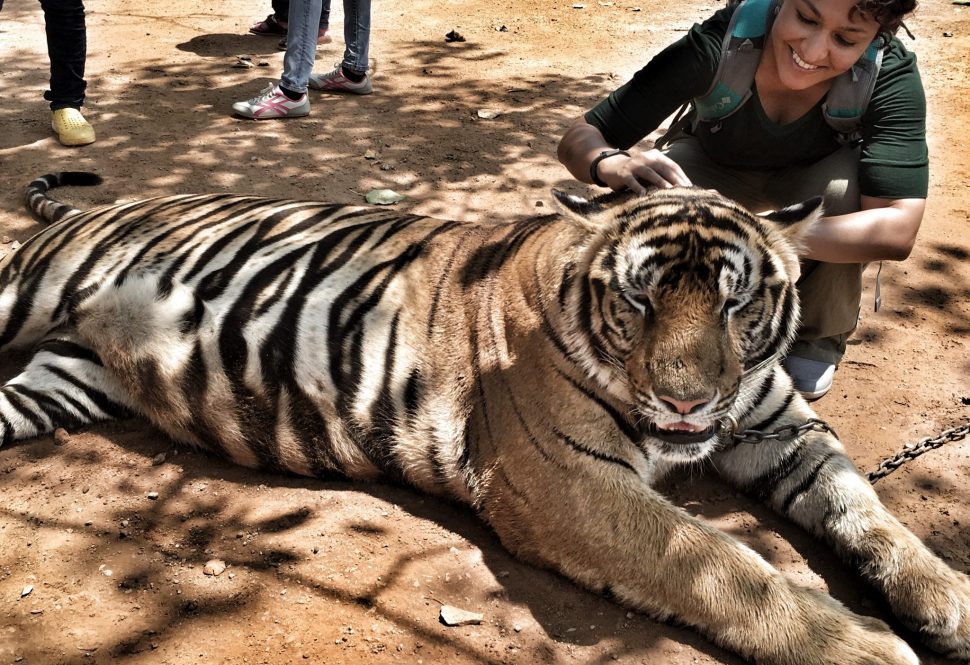
History of the Tiger Temple
Wat Pha Luang Ta Bua Yanasampanno was started in 1994 as a forest temple and Buddhist Monastery. Since then it has grown from a place of worship by Buddhist Monks to a sanctuary for a number of different type of animals thanks to an injured fowl given to the monks by villagers nearby. Soon peacocks showed up attracted by calls of a flock of jungle fowl that had made the monastery grounds in the forest their home. Then came an injured wild boar and the monks cared for it till it could be released back into the wild.
However, it was a little tiger cub that was first brought to the monks by local villagers in 1999 that shaped the future of the sanctuary. The villagers had rescued the animal after poachers killed the mother, and a wealthy Bangkok resident had arranged for a taxidermist to have it stuffed. He had already injected the cub with preservative formalin when the villagers rescued her. She was brought to the monastery, which by then had gained a reputation for being a sanctuary for injured animals.
In 2010, WWF sounded the alarm for the Indochinese tiger because the population of this subspecies had fallen by more than 70% in just over a decade.
Due to decades of rampant poaching, six countries—Thailand, Cambodia, China, Lao People’s Democratic Republic, Myanmar and Vietnam—are now home to only around 350 tigers
Thai poachers can get up to $6000 for killing a tiger, more money than any of them have ever imagined. When mother tigers are killed, the cubs are either taken as a bonus or left to fend for themselves in the wild, where more often than not, they cannot survive on their own. Cubs need their mother till they are at least 2 years old.
Soon after that first tiger cub arrived, villagers and border police patrol rescued several more cubs from poachers and brought them to the monastery. Since then, the Tiger Temple has grown into a safe sanctuary that today houses 137 tigers who are cared for by the monks, along with trained staff and a team of volunteers.
What I Saw
We arrived at the Tiger Temple around 12.30 PM, a few minutes after the tigers are brought to the Saifa Waterfall Area (named after their first Tiger). Only 16 tigers are brought to meet the visitors on a given day.
At the entrance, we had to sign a disclaimer relieving the Tiger Temple of any liabilities (you know, in case one of the big cats decided to swipe your face!).

The entrance to the forest monastery was a huge contrast to the town of Kanchanaburi I had seen so far. The red soil, the wide dirt road lined with Flame of the Forest trees, the vegetation, red brick walls and the deep burgundy clay created a unique setting. As soon as we entered the gates, I saw a family of pigs foraging around in the dirt. A cow and a horse wandered about nearby.

Halfway down the dirt path, this tablet caught my attention. Clearly, I wasn’t going to find peace in this lifetime. I do like a nice, large, comfortable couch!
We finally approached an open area and there they were, a group of tigers, lying under a cluster of trees surrounded by Tiger Temple Staff (identifiable by their T-Shirts) and volunteers (in pink T-shirts) who were arranging for the tourists to get their pictures taken with the tigers. I don’t think I quite expected to be getting so close to them in such an open setting as soon as I arrived. I guess I was expecting we would be taken to some closed area and would be shuffled along in a line for photos. So this was a pleasant surprise.
Some tigers were just sitting peacefully in the shade of the trees (it was nearly 40 deg C), some were playing with their handlers, and one was being hand fed by a staff member.
They have an efficient system where the staff will guide you by hand to approach the tiger from the back where you crouch down and pat it while one of the pink T-shirted volunteered will take your phone/camera and snap the photograph. The staff member told me to pat or stroke the tiger firmly, as opposed to softly, since the tiger could mistake a soft touch as a fly and try to swat it with its tail or leg and you do not want to be at the receiving end of that.

At 1 PM the tourists are lined up and briefed about the walk to the Tiger Canyon and the Dos and Don’ts around it. Tigers are walked by their leash down a 1 km stretch to the Canyon. Visitors are allowed to hold the leash and walk with the tiger and get their picture taken. One by one, each person arrives at the front of the line and a volunteer takes your camera, as a staff member hands the leash to you. You get to walk the tiger for about 10 seconds as your picture is taken and then you hand the leash back to the staff member, and go to the back of the line.
Visitors are not allowed to take their own photos and those who thought they could ignore the rules and walk away from the group or approach the tiger themselves are quickly scolded away.

We followed the tigers down to the area known as the Tiger Canyon, with high canyon walls along the sides, where a number of tigers are milling about lazily or dozing. They are chained to either a tree or to the ground. A medium height metal fence separates the tigers from the tourists.

Every time a tiger was walked into the canyon, followed by a line of tourists, our group of visitors would be asked to stand and face the tiger as it walked. There are two rules: don’t sit in front of a tiger, and don’t turn your back to a tiger. Typically tigers by instinct attack smaller animals, and they attack from the back. The last tourist injured by a tiger cub had to get ten stitches on her leg because she ignored both these rules!

At the canyon entrance, Ron, an Indian staff member gave us a briefing and answered our questions. Then we were given different options – you could pay to have a ‘special’ photo taken with a tiger’s head on your lap, or you could line up to get some free photos. I lined up for the freebie!
Click on image to enlarge
I have read allegations that the tigers are drugged in order for tourists to interact with them. Having seen them at close quarters and after reading about tigers in their natural habitat, to my untrained eye, these tigers definitely did not seem drugged. A tiger is a nocturnal animal. In the wild, tigers apparently sleep for 18-20 hours a day and hunt for a few hours when it’s dark. While these tigers at the temple do not hunt, they do a lot of sleeping or lazing about exactly the same way as their counterparts in the wild.
At the Saifa Waterfall area I saw one of the tigers running around in circles around the tree to which it was chained in an agitated manner (definitely not sedated) and his handler arrived and started talking to him and it was amazing to see how quickly he calmed down and simply sat back on the ground. I started filming only about a minute after he started running.
During the Q&A with the staff, I found out that the tigers are fed boiled chicken and vitamin supplements. None of them have actually tasted blood. They are exercised every morning and evening. A special program at 3.30 PM involves playing and exercising the tiger cubs, which I did not stay for.
Not all of the tigers were on display for the public. Many have been rescued from the black market trade where they would have ended up in exotic traditional Chinese medicines or “tiger wine”. Rescue tigers are not suitable for public display, which makes sense. Others just didn’t have the right temperament for human interaction.
Here are some deer grazing in the temple grounds, barely 100 feet from the tigers.
After I returned to the US, I watched the Netflix documentary called The Tiger and the Monk, which portrays the harmonious relationship between the tigers and the humans that care for them. It traces the journey of how a place of worship inadvertently became one of the most popular tourist destinations and wildlife conservation sanctuaries in Thailand.

The Tiger Temple, being a Buddhist centre does not get any government funding. The place relies solely on donations. The temple sees between 300 and 600 visitors each day. All the money raised by the tours goes towards looking after the tigers: paying for medicine, food, veterinary care, building and maintenance of pens and more recently the ambitious Tiger Island project.
The Chief Abbot Phra Acham Phusit, the head of the monastery and the man behind the sanctuary, wanted to create a large open-air enclosure that would allow the tigers to live and experience life in a setting that was as close to their natural habitat as possible. Construction of the Tiger Island started in 2003 and is now nearly complete. The skywalk is now open and a majority of the tigers that are not brought out to meet the visitors can be viewed from here.

So, is the Tiger Temple a genuine sanctuary for animals, or is it a tourist trap and a front for illegal tiger trade as alleged by the naysayers? Based on what I saw and felt, there is a sense of peace and calm about the place, the animals seem well looked after and the staff genuinely passionate about what they do. It cannot be easy for a group of unworldly, untrained monks to run a large wildlife sanctuary. It is clearly expensive and they need help running the place, and make it self-sufficient.
It is a tourist trap and I won’t deny it. But as Phra Acham said in the Netflix documentary – “I will do whatever it takes to provide a safe sanctuary for these animals from poachers and the black market. If that means I have to pose for a newspaper photo riding a tiger, to create awareness of what we do here, I am happy to do it.”












[…] Read Part 2 of my trip to Kanchanaburi – The Monks who Tamed the Tiger […]
thank you very much for sharing, I had seen the documentary and thought of a tiger paradise, Then read the headline and was saddened, now I’m happy again and fully understand the Monk who does what it takes to keep them away from the deadly market. Malvina (BsAs)